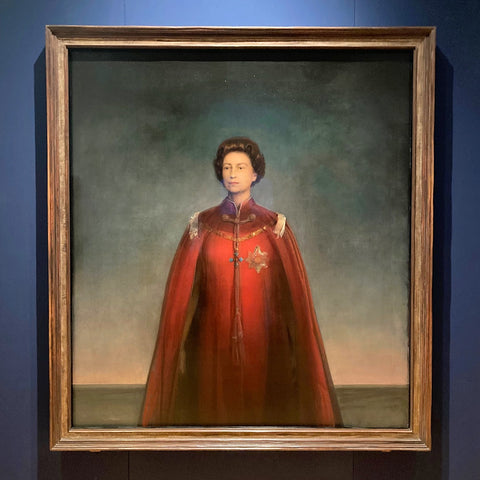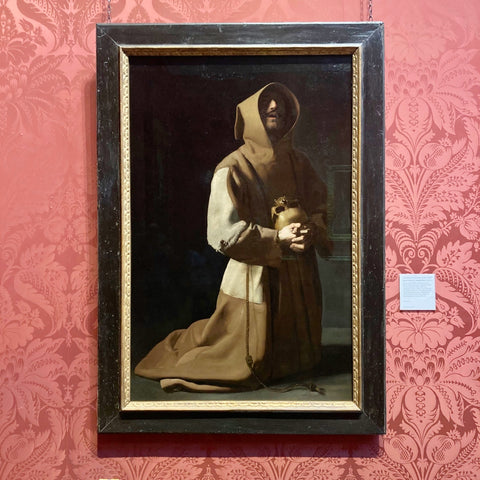
Shopping, theatre and museums! My three favorite things to do while in London. Having finished packing-up all my purchases (thus far), I headed to Trafalgar Square to visit the National Portrait Gallery and the National Gallery of Art—two of the great art museums in the world.
Shown above, a portrait of Queen Elizabeth II, painted in 1969. The trustees of the National Portrait Gallery wanted to commission a new portrait of Her Majesty for their collection and the Queen expressed interest in sitting for Italian portraitist Pietro Annigoni (who had painted her 15 years earlier, as a young queen). It took 18 sittings (over 10 months) before the painting was unveiled in 1970. The bold, regal likeness—with its monumental, Modernist composition—captured the public's attention. Says the artist, "I did not want to paint her as a film star; I saw her as a monarch, alone in the problems of her responsibility."

This may be the only portrait of William Shakespeare (1564-1616) painted from life, the sitter and the artist together. It is also the very first portrait to be acquired by the National Portrait Gallery when it was founded in 1856. It is believed to have been painted by John Taylor (circa 1600-10).

For me, Vincent Van Gogh never ages. His paintings look as fresh and beautiful today as they did on the day they were created—150 years ago. The joy, energy, life and beauty of this picture, A Wheatfield, With Cypresses, belies the pain and depression the artist was suffering as he painted it. It was painted in the final autumn of his life, as he was locked in a psychiatric hospital, less than a year before he killed himself in July of 1890, aged 37. He had done a study a few months earlier, en plein air. This was his finished painting, made from that original study. He also made a smaller one for his mother and sister. It is remarkable to consider the beauty this artist was able to create—sunny and fresh and joyful—while he was tormented with mental illness, physical pain and destitution. I will always be grateful for Van Gogh—one of the greatest artists who ever lived.

This Portrait of a Young Man by Florentine painter Andrea del Sarto (1486-1530), holds a few secrets. Who is the man? Some suspect it may be a self-portrait of the artist himself. What is he holding? Is it a book? Sculpting materials? Some have called this picture Portrait of a Sculptor. It was painted in 1517-1518. It is a handsome painting of a handsome man. That's enough for me.

Dutch master, Johannes Vermeer (1632-1675) painted this portrait circa 1670-1672. It is a serene scene of a young woman standing at a virginal (a harpsichord-like instrument). In typical Vermeer fashion, the subject is female and looks directly at the viewer. The light streams-in from the upper left. And the painting is packed with clues which convey the meaning of the picture. In this case, the painting of Cupid indicates an image of idealized love. Vermeer painted a companion piece with the young woman seated at the virginal. Perhaps they are the same woman? Recent high-tech scans indicate that the two canvasses were cut from the same bolt of fabric.

Another artist whom I always admire is Francisco de Zubarán (1598-1664). His dark themes and foreboding use of chiaroscuro (dramatically contrasting dark and light paints) earned him the nickname "the Spanish Caravaggio." Here he portrays Saint Francis of Assisi in Meditation, head obscured by his Capuchin hood, clutching a skull—a symbol of his mortality. It is a bold, simple and dramatic painting—quite modern for something painted circa 1635-1639.
Though our Greenwich Village store is now permanently closed, LEO Design is still alive and well! Please visit our on-line store where we continue to sell Handsome Gifts (www.LEOdesignNYC.com).
We also can be found in Canonsburg, Pennsylvania, at The Antique Center of Strabane (www.antiquecenterofstrabane.com).
Or call to arrange to visit our Pittsburgh showroom (by private appointment only). 917-446-4248

